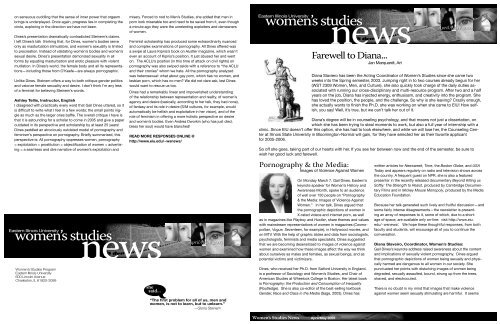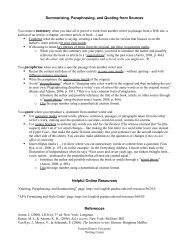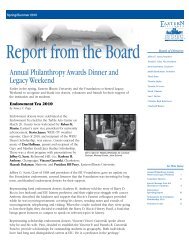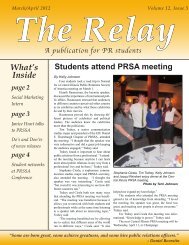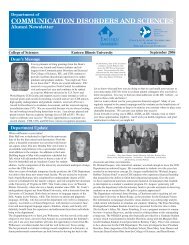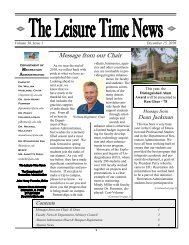You also want an ePaper? Increase the reach of your titles
YUMPU automatically turns print PDFs into web optimized ePapers that Google loves.
on sensuous cuddling that the sense of inner power that orgasm<br />
brings is underplayed. Once again, progress lies in completing the<br />
circle, exploring in the direction we have not been.<br />
Dines’s presentation dramatically contradicted Steinem’s claims.<br />
I left Dines’s talk thinking that, for Dines, women’s bodies serve<br />
only as masturbation stimulators, and women’s sexuality is limited<br />
to procreation. Instead of validating women’s bodies and women’s<br />
sexual desire, Dines’s presentation demonized sexuality in all<br />
forms by equating masturbation and erotic pleasure with violent<br />
mutilation. In Dines’s world, the female body and all its representations—including<br />
those from O’Keefe—are always pornographic.<br />
Unlike Dines, Steinem offers a way to both critique gender politics<br />
and valorize female sexuality and desire. I don’t think I’m any less<br />
of a feminist for believing Steinem’s words.<br />
Ashley Tellis, Instructor, English<br />
I disagreed with practically every word that Gail Dines uttered, so it<br />
is difficult to write what I feel in a few words; the small points niggle<br />
as much as the larger ones baffle. The overall critique I have is<br />
that it is astounding for a scholar to come in 2005 and give a paper<br />
outdated in its perspective and scholarship by at least 25 years!<br />
Dines peddled an atrociously outdated model of pornography and<br />
feminism’s perspective on pornography. Briefly summarized, this<br />
perspective is: All pornography oppresses women, pornography<br />
= exploitation = prostitution = objectification of women = advertising<br />
= a seamless and dire narrative of women’s exploitation and<br />
<strong>Eastern</strong><br />
women’s<br />
<strong>Illinois</strong> <strong>University</strong><br />
studies<br />
news<br />
April/May 2005<br />
<strong>Women</strong>’s Studies Program<br />
<strong>Eastern</strong> <strong>Illinois</strong> <strong>University</strong><br />
600 Lincoln Avenue<br />
Charleston, IL 61920-3099<br />
misery. Forced to nod to Men’s Studies, she added that men in<br />
porn look miserable too and need to be saved from it, even though<br />
a minute ago they were the unrelenting exploiters and demeaners<br />
of women.<br />
Feminist scholarship has produced some extraordinarily nuanced<br />
and complex examinations of pornography. All Dines offered was<br />
a swipe at Laura Kipnis’s book on Hustler magazine, which wasn’t<br />
even an account of Kipnis’s position. It just abused her and went<br />
on. The ACLU’s position (in this time of attack on civil rights) on<br />
pornography was also swiped aside with a reference to “the ACLU<br />
and their cronies” whom we hate. All the pornography analyzed<br />
was heterosexual: what about gay porn, which has no women, and<br />
lesbian porn, which has no men? We did not dare ask, lest Dines<br />
would want to rescue us too.<br />
Dines had a remarkably linear and impoverished understanding<br />
of the relationship between representation and reality, of women’s<br />
agency and desire (basically, according to her talk, they had none),<br />
of fantasy and its role in desire (S/M cultures, for example, would<br />
automatically be hellish and exploitative in her vision), and of the<br />
role of feminism in offering a more holistic perspective on desire<br />
and women’s bodies. Even Andrea Dworkin (who has just died,<br />
bless her soul) would have blanched!<br />
READ MORE RESPONSES ONLINE @<br />
http://www.eiu.edu/~wsnews/<br />
(she<br />
said...<br />
“The first problem for all of us, men and<br />
women, is not to learn, but to unlearn.”<br />
—Gloria Steinem<br />
news<br />
<strong>Eastern</strong><br />
women’s<br />
<strong>Illinois</strong> <strong>University</strong><br />
studies April/May 2005<br />
Pornography & the Media:<br />
Images of Violence Against <strong>Women</strong><br />
On Monday March 7, Gail Dines, <strong>Eastern</strong>’s<br />
keynote speaker for <strong>Women</strong>’s History and<br />
Awareness Month, spoke to an audience<br />
of well over 150 people on “Pornography<br />
& the Media: Images of Violence Against<br />
<strong>Women</strong>.” In her talk, Dines argued that<br />
the pornographic depictions of women in<br />
X-rated videos and internet porn, as well<br />
as in magazines like Playboy and Hustler, share themes and values<br />
with mainstream representations of women in magazines (Cosmopolitan,<br />
Vogue, Seventeen, for example), in Hollywood movies, and<br />
on MTV. With the help of graphic slides and data from sociologists,<br />
psychologists, feminists and media specialists, Dines suggested<br />
that we are becoming desensitized to images of violence against<br />
women and examined how these images affect the way we think<br />
about ourselves as males and females, as sexual beings, and as<br />
potential victims and victimizers.<br />
Dines, who received her Ph.D. from Salford <strong>University</strong> in England,<br />
is a professor of Sociology and <strong>Women</strong>’s Studies, and Chair of<br />
American Studies at Wheelock College in Boston. Her latest book<br />
is Pornography: the Production and Consumption of Inequality<br />
(Routledge). She is also co-editor of the best-selling textbook<br />
Gender, Race and Class in the Media (Sage, 2003). Dines has<br />
<strong>Women</strong>’s Studies News April/May 2005<br />
Farewell to Diana...<br />
Jan Marquardt, Art<br />
Diana Slaviero has been the Acting Coordinator of <strong>Women</strong>’s Studies since she came two<br />
weeks into the Spring semester, 2003. Jumping right in to two courses already begun for her<br />
(WST 2309 <strong>Women</strong>, Men, and Culture), she also quickly took charge of the daily duties associated<br />
with running our cross-disciplinary and multi-resource program. After two and a half<br />
years on the job, Diana has injected energy, enthusiasm, and creativity into the program. She<br />
has loved the position, the people, and the challenge. So why is she leaving? Crazily enough,<br />
she actually wants to finish the Ph.D. she was working on when she came to EIU! How selfish,<br />
you say! Well, it’s true, but we can’t talk her out of it.<br />
Diana’s degree will be in counseling psychology, and that means not just a dissertation, on<br />
which she has been trying to steal moments to work, but also a full year of internship with a<br />
clinic. Since EIU doesn’t offer this option, she has had to look elsewhere, and while we will lose her, the Counseling Center<br />
at <strong>Illinois</strong> State <strong>University</strong> in Bloomington-Normal will gain, for they have selected her as their favorite applicant<br />
for 2005-2006.<br />
So off she goes, taking part of our hearts with her. If you see her between now and the end of the semester, be sure to<br />
wish her good luck and farewell.<br />
written articles for Newsweek, Time, the Boston Globe, and USA<br />
Today and appears regularly on radio and television shows across<br />
the country. A frequent guest on NPR, she is also a featured<br />
presenter in the recently released documentary Beyond Killing us<br />
Softly: The Strength to Resist, produced by Cambridge Documentary<br />
Films and in Mickey Mouse Monopoly, produced by the Media<br />
Education Foundation.<br />
Because her talk generated such lively and fruitful discussion—and<br />
some fairly intense disagreements—the newsletter is presenting<br />
an array of responses to it, some of which, due to a shortage<br />
of space, are available only on-line: visit http://www.eiu.<br />
edu/~wsnews/. We hope these thoughtful responses, from both<br />
faculty and students, will encourage all of you to continue the<br />
conversation.<br />
Diana Slaveiro, Coordinator, <strong>Women</strong>’s Studies:<br />
Gail Dines’s keynote address raised awareness about the content<br />
and implications of sexually violent pornography. Dines argued<br />
that pornographic depictions of women being sexually and physically<br />
harmed are dangerous to all women in our society. She<br />
punctuated her points with disturbing images of women being<br />
degraded, sexually assaulted, bound, strung up from the trees,<br />
shaved, and electrocuted.<br />
There is no doubt in my mind that images that make violence<br />
against women seem sexually stimulating are harmful. It seems
preposterous to me that any reasonable person could argue otherwise.<br />
However, pornography has always sparked heated debate.<br />
Many differing points of view about pornography have been passionately<br />
discussed here at EIU as a result of Dines’s presentation.<br />
Many individuals argue that pornographers should have the right<br />
to produce and sell porn because to restrict them would infringe<br />
on their freedom of speech. Often, the people who make this argument<br />
are the same people who choose not to view pornography<br />
and are blissfully unaware of the content of many pornographic<br />
films, magazines, and internet sites. In order to develop an informed<br />
opinion on the subject, I believe that people need to be<br />
exposed to the material at the heart of the discussion. Dines was<br />
a dynamic, articulate speaker who analyzed the production and<br />
consumption of pornography with a keen feminist sensibility. She<br />
has her own firmly held convictions, but ultimately, she challenged<br />
her audience to develop an informed opinion for themselves about<br />
the consequences of pornography.<br />
Tiffany Swiderek, student, WST 2309:<br />
I left Gail Dines’s presentation on pornography with a whole new<br />
outlook on something I used to blow off as “boys will be boys.”<br />
Dines defined pornography as sexualizing abuse of women, and<br />
drove her point home with numerous images, explanations, and<br />
stories.<br />
I always knew Playboy, Playpen, and Hustler were three of the<br />
most popular “men’s” magazines. I never realized how explicit,<br />
demeaning, and abusive Hustler magazine was towards women.<br />
First of all, I can’t believe some of the images they print are even<br />
legal, and second of all, I can’t imagine what kind of sick male<br />
would actually get off looking at something so disgusting and<br />
unrealistic.<br />
Dines talked about abuse of women and children and how images<br />
of pornography act as “scripts” for men to act out. . . . I left the<br />
presentation shocked that pornography has such a huge impact<br />
on today’s society.<br />
Newsletter Staff<br />
Director of <strong>Women</strong>’s Studies: Diana Slaveiro<br />
Newsletter Editors: Ruth Hoberman and Lynanne Page<br />
Newsletter Design: Stacia Lynch<br />
Sace Elder, Assistant Professor, History:<br />
It is a testament to the merits of Gail Dines’s talk that there has<br />
been so much discussion of her presentation on campus since<br />
March 7. Graduate students in my modern European women’s history<br />
course, for example, spent a good hour debating the issue of<br />
pornography and making fruitful comparisons between contemporary<br />
debates about pornography and the late nineteenth-century<br />
feminist debates about prostitution. Dines’s powerful images and<br />
provocative language effectively conveyed the misogyny typical<br />
of the porn industry. Pornography that begins with the playful<br />
images of Playboy Playmates shades – inexorably, Dines argues<br />
– into the much more sexually explicit and misogynist Hustler<br />
FEEDBACK FEEDBACK FEEDBACK FEEDBACK FEEDBACK<br />
FEEDBACK FEEDBACK FEEDBACK FEEDBACK FEEDBACK<br />
FEEDBACK FEEDBACK FEEDBACK FEEDBACK FEEDBACK<br />
FEEDBACK FEEDBACK FEEDBACK FEEDBACK FEEDBACK<br />
FEEDBACK FEEDBACK FEEDBACK FEEDBACK FEEDBACK<br />
FEEDBACK FEEDBACK FEEDBACK FEEDBACK FEEDBACK<br />
Dines<br />
and finally into the graphic sexual violence of snuff films and<br />
internet porn. Clearly the popularity of these representations of<br />
the sexualized female body (the porn industry grosses more than<br />
movies and video games, Dines tells us) as well as the conditions<br />
under which many of those real women work in producing those<br />
images reveal the persistence of male domination in our society (I<br />
would not call it “patriarchy” as Dines does) as well as an alarming<br />
disconnect between male and female sexuality. Pornography has<br />
consequences not just for women but for men as well: How is it<br />
possible, Dines asks us, for men and women to have truly intimate<br />
and human sexual relationships when the male sexual imagination<br />
is shaped by such violent and disturbing images?<br />
It would be difficult to argue that the disturbing images Dines<br />
presented were not exploitative of the women in them. In the<br />
end, it is the production of these images and the issues of labor<br />
that should be of the most immediate concern. The conditions<br />
of labor that place women, in particular, at risk and the alienation<br />
of these women from the enormous capital their labor generates<br />
are symptomatic of a capitalist society that is and has historically<br />
been dependent upon an abundant supply of cheap female labor.<br />
Such was also Dines’s self-professedly Marxist critique of the porn<br />
industry, although she spent little time discussing how these labor<br />
issues might be addressed.<br />
There are several aspects of the pornography problem I would<br />
have liked to hear Dines address more adequately. When asked,<br />
for example, if there might be an alternative eroticism that was<br />
affirming of women and promoted human intimacy, Dines had little<br />
to say. This issue seems to have been of particular concern to one<br />
remarkably frank young man in the audience, who wondered how<br />
he could imagine sex differently than how it is portrayed by the<br />
pornographers. Dines told the young man she was sorry his sexuality<br />
had been hijacked and that she didn’t know if he would ever<br />
be able to reclaim it. Not very encouraging, and yet alternatives<br />
are crucial if we hope to develop into fully realized sexual individuals.<br />
And it seems that in the case of this young man (and many like<br />
him) the problem isn’t just the pornography, but the sexual moralism<br />
that combats positive and public sex education and forces<br />
youths (primarily young boys) into the arms of pornographers to<br />
learn what they know of sex and female bodies.<br />
Of course, one of Dines’s main points was that young people<br />
don’t even have to visit a porn site or watch an X-rated film to be<br />
“educated” on exploitation. Vanity Fair, Cosmopolitan, Seventeen<br />
– one can find violent and sexually suggestive images of women<br />
everywhere in mainstream media. That there are certain continuities<br />
in the representations of the female form in mainstream media<br />
and pornography is clear (although not all of Dines’s examples<br />
served her well in this regard). What is less clear is why this is so.<br />
Dines seemed to suggest simultaneously that mainstream media<br />
are mimicking the porn industry’s repertoire for financial gain,<br />
and that both popular advertising and pornography operate in<br />
the same cultural register that dominates and exploits women.<br />
One of the key problems to be explained, it seems to me, is why<br />
the sexualized body is necessarily the female body. <strong>Women</strong>’s<br />
magazines feature images of sexy women because those are the<br />
images that suggest to us (men and women alike) sexual desire.<br />
In that sense, the pornographers tap into a hegemonic sexuality in<br />
which women are the objects of desire and the sexual gaze is the<br />
male gaze.<br />
Perhaps to combat pornography we must not only attack the<br />
exploitative ways in which it is produced, but also find alternative<br />
ways of imagining, thinking about, and talking about sexual bodies.<br />
Rich Foley, Assistant Professor, Philosophy:<br />
“I put my arms around him yes and drew him down to me so he<br />
could feel my breasts all perfume yes and his heart was going<br />
like mad and yes I said yes I will Yes.” Does reading this passage<br />
make heterosexual men desire to pluck Molly Bloom’s mountain<br />
flower? Undoubtedly it does, and such desires affect behavior as<br />
well. However, this uncontroversial claim is not sufficient to justify<br />
censorship in the way that Gail Dines suggests.<br />
Minimally, Dines requires the additional claim that the behavior<br />
resulting from enjoying pornography will mimic the behavior depicted<br />
by the pornography. If the aestheticization of rape changes<br />
male behavior, but in a way that is not in fact harmful to women,<br />
then there is no reason to censor it—abridging civil rights can be<br />
justified only by the harm that would result if the rights were not<br />
limited. Although most of Dines’s lecture was designed to support<br />
this claim, I do not believe that her argument was successful.<br />
Indeed, I think her talk was fundamentally inconsistent on this<br />
point given her frequent and often gratuitous use of pornographic<br />
images.<br />
Dines argued that pornography leads men to desire depictions<br />
of women in ever more demeaning sexual positions, and that<br />
ultimately men prefer images of gang-rape or of women depicted<br />
as children. Dines asserts that men will imitate these images,<br />
resulting in violence against women and children. This mimetic<br />
theory originates with Plato’s Republic, yet the refutation is almost<br />
as old, and was offered by Plato’s student, Aristotle. Aristotle<br />
argued (when faced with the violence depicted in Greek tragedy)<br />
that graphic violence enables the audience to purge themselves of<br />
their impure, anti-social drives. Which theory is correct is an empirical<br />
matter, but I suspect that the societies with severe restrictions<br />
on pornography tend to have the greatest repression and<br />
violence against women. It is obvious that pornography affects<br />
behavior, but if Aristotle’s theory of catharsis is correct, restriction<br />
of pornography would lead to an increase of the very behaviors<br />
Dines so justly condemns.<br />
Robin Murray, Associate Professor, English:<br />
A few years into my tenure here at <strong>Eastern</strong>, my colleague Linda<br />
Coleman passed along a quotation from Joanne Callahan that<br />
hangs on my office wall right beside a Georgia O’Keefe print:<br />
“Twenty years ago, I just didn’t understand the radicals’ ideas. But<br />
after seeing liberal feminism’s limitations, my philosophy is becoming<br />
more radical. To my dismay, the effect of all those crucial<br />
liberal feminist reforms was the modernization of patriarchy, not<br />
the abolition of it,” Callahan declares.<br />
The juxtaposition of the quotation with the print speaks well to my<br />
reading of Gloria Steinem’s essay “Body of Knowledge” and illustrates<br />
my discomfort with elements of the recent Gail Dines lecture<br />
on pornography. Like Callahan, I embrace some radical feminist<br />
philosophies, and like O’Keefe, I find the female body beautiful<br />
and erotic—and don’t feel as if I’m objectifying myself or other<br />
women by stating these beliefs. In “Body of Knowledge,” Steinem<br />
articulates for a broad general audience how much of “our sense<br />
of ourselves resides in our body.” While Steinem agrees that<br />
women need to encourage more powerful and positive images of<br />
women in media like film, she also recognizes the importance of<br />
nurturing the body and recognizing its fundamental connection<br />
with the mind. For example, she explains that “new techniques for<br />
tracking the development of the living brain suggest that touch is<br />
the primary source of neurochemical changes in infancy.”<br />
For Steinem, sexuality serves as an integral element of this mindbody<br />
connection and is an essential source for building strong<br />
self-esteem and self-concept. According to a text on the medical<br />
aspects of human sexuality, “Orgasm and other forms of sexual<br />
expression are such a source of self-affirmation that two thirds of<br />
psychiatrists believe people ‘nearly always or often’ lose self-esteem<br />
when deprived of a ‘regular outlet for sexual gratification.’”<br />
A long quote from Steinem will explain why I think Dines misrepresented<br />
women’s sexuality in her talk. For Steinem, orgasm<br />
is so central to our being that, as countless studies have shown,<br />
masturbation is instinctive from a very early age. In later life, sexuality<br />
and sensuality are also ways we express ourselves and ‘talk’<br />
to each other: unlike other animals, for whom sex seems to be<br />
focused in times of ‘heat’ or estrus when conception is most likely,<br />
human sexual pleasure exists independently of conception, and<br />
so is a way we communicate as well as procreate. Given gender<br />
politics, however, men may be so genitally focused that they miss<br />
whole-body sensuousness, while women may focus so much<br />
<strong>Women</strong>’s Studies News April/May 2005 Apruil/May 2005 <strong>Women</strong>’s Studies News


